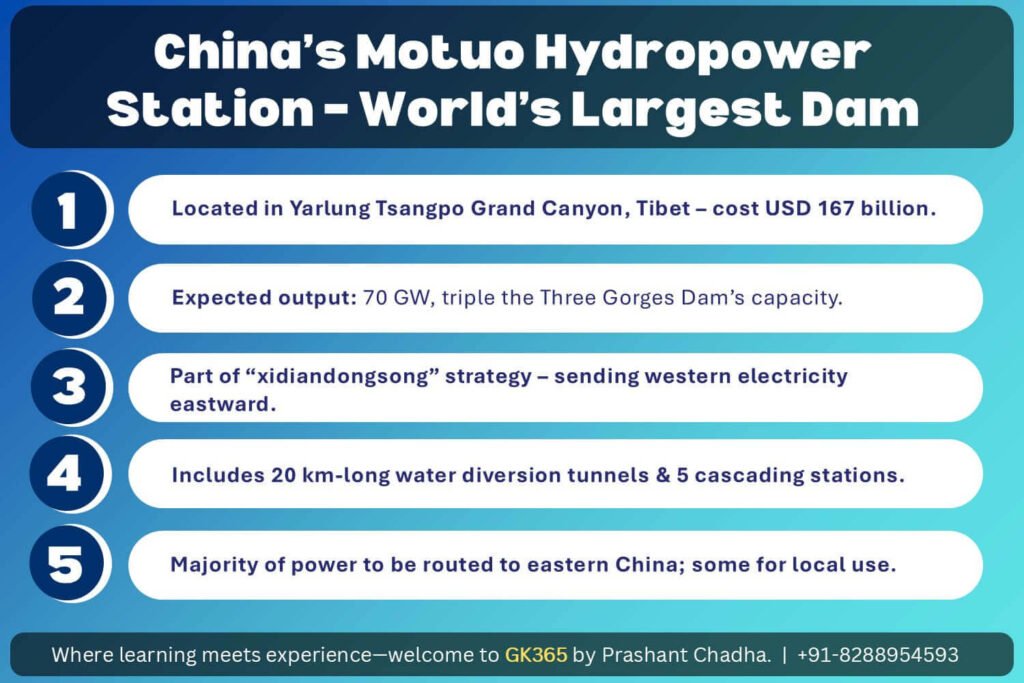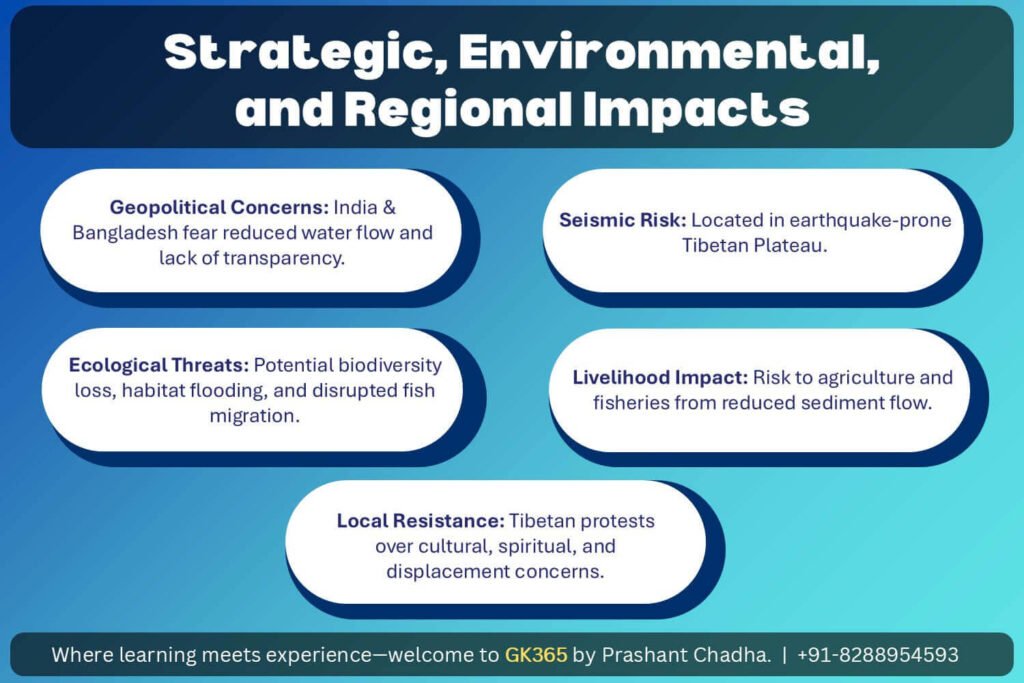China’s Mega Dam on Yarlung Tsangpo: Energy Gains and Strategic Strains
Table of Contents
- Introduction
- Project Overview
- Geographic and Strategic Context
- Energy and Engineering Ambitions
- Project Objectives and Features
- Regional Geopolitical Impact
- Environmental and Ecological Risks
- Local Resistance and Human Impact
- Conclusion
- Key Takeaways Table
1. Introduction
China is building the world’s largest hydropower dam on the Yarlung Tsangpo River in Tibet. Called the Motuo Hydropower Station, the project aims to produce huge amounts of clean electricity. But it raises concerns for India and Bangladesh, which rely on the river downstream. The dam ties together energy needs and political influence. It also creates worries about environmental safety, earthquakes, and control of cross-border water.

2. Project Overview
The dam is set deep in the Yarlung Tsangpo Grand Canyon, one of the world’s deepest gorges. It will surpass China’s Three Gorges Dam in both size and power. Premier Li Qiang oversees the project, showing how much it matters to China’s leadership.
The total cost is about 1.2 trillion yuan, or USD 167 billion. When complete, it will generate over three times more power than the Three Gorges Dam. That makes it the largest and most powerful hydropower station built so far.
3. Geographic and Strategic Context
The Yarlung Tsangpo starts in the Tibetan Plateau. It flows east across Tibet, then turns south into India as the Siang River in Arunachal Pradesh and becomes the Brahmaputra in Assam. In Bangladesh, it’s called the Jamuna.
Since the river begins in Tibet, China controls the flow. India and Bangladesh need this water for farming, drinking, and industry. The dam site is also in a zone prone to earthquakes.
Motuo County, where the dam is being built, is remote and rich in nature. Building anything here is expensive and hard on the environment.
4. Energy and Engineering Ambitions
The project supports China’s “xidiandongsong” plan, which means sending power from west to east. The idea is to use western hydropower to meet eastern demand.
The project includes five linked dams. Water will pass through tunnels 20 kilometers long before turning turbines. This energy will go into China’s main power grid. While most electricity goes to other regions, some will stay in Tibet.
The engineering work is intense. The land is rough, roads are few, and weather is harsh. Teams must drill and tunnel with high precision.
5. Project Objectives and Features
Main goals and design details include:
- Electricity Output: About 70 gigawatts, three times more than the Three Gorges Dam.
- National Grid Supply: Most power will go to eastern China.
- Tunnel System: Long water tunnels will improve flow and energy output.
- River Flow Changes: Some straightening of the river to improve efficiency.
- Local Use: A portion of the power will serve people nearby.
This kind of construction, in such a fragile zone, has few parallels.
6. Regional Geopolitical Impact
India’s Concerns
India is uneasy. It fears China might reduce river flow during dry spells or release large volumes during floods. The dam gives China potential control in disputes. The risk of using the dam as a weapon exists, though it would hurt China too.
Tensions already run high over the Arunachal Pradesh region. The river flows through this disputed area. Now, water security adds to the strain.
Bangladesh’s Concerns
Bangladesh has asked China for updates on water levels and dam operations. The country depends on steady river flow for farming. Changes could damage food supply.
China has signed global water and climate treaties. But these don’t require it to share river water. That leaves Bangladesh and India exposed.
China’s Stand
China says this is a local project meant for clean power. It denies any political goal. Officials argue that hydropower is better than coal and helps meet climate targets.
Still, secrecy around the plan adds to regional distrust.
7. Environmental and Ecological Risks
Earthquake Risk
The Tibetan Plateau often sees strong earthquakes. A large quake could damage the dam or cause landslides. These could hurt nearby villages and roads. While engineers may add safeguards, the danger remains real.
Biodiversity Threats
The area holds many rare species. Some live only in this region. The project could destroy their homes. Valleys that support plants and animals will be flooded. Many species can’t move or adapt quickly enough.
The dam will also harm wetlands and fish migration routes.
Sediment Blockage
Big dams block the natural flow of sediment. That silt feeds farms in India and Bangladesh. Without it, soil loses fertility. Crop yields may fall. Fishing will also suffer as river health drops.
8. Local Resistance and Human Impact
Tibetan Opposition
Tibetans have protested large dams before. Many demonstrations led to arrests and injuries. Locals believe the rivers are sacred. Changing their course feels like an attack on faith and tradition. The area holds monasteries and ancient knowledge tied to the river.
Displacement of People
Though few people live in Motuo, some groups may still be forced to leave. The government has shared little about plans for moving them or what help they’ll get.
Earlier resettlements in China had mixed results. Some communities received aid. Others got little support or poor living conditions.

9. Conclusion
The Motuo Hydropower Station is a bold and massive project. It could supply clean energy on a huge scale. But it brings big risks, especially for India and Bangladesh. These countries want more openness from China.
The dam sits in a quake-prone and rich ecological zone. That makes its impact hard to predict. Power needs are urgent, but so are the health of the river and peace in the region.
China has a chance to lead. It can work with neighbors, share plans, and protect nature. The world is not just watching the power it generates—but what it might change forever.
Key Takeaways Table
| Aspect | Details |
|---|---|
| Project Scale | Aims to generate 70 GW—largest hydropower output globally. |
| Strategic Location | Built in Tibet on a transboundary river crucial to India and Bangladesh. |
| Engineering Feats | Includes 20 km tunnels and complex systems in harsh terrain. |
| Energy Purpose | Powers China’s east via “xidiandongsong” plan; partial use in Tibet. |
| Geopolitical Impact | Sparks water security fears and diplomatic strain with neighbors. |
| Ecological Concerns | Threatens rare biodiversity, wetlands, and sediment flows downstream. |
| Local and Cultural Resistance | Tibetan protests due to displacement and spiritual river significance. |

